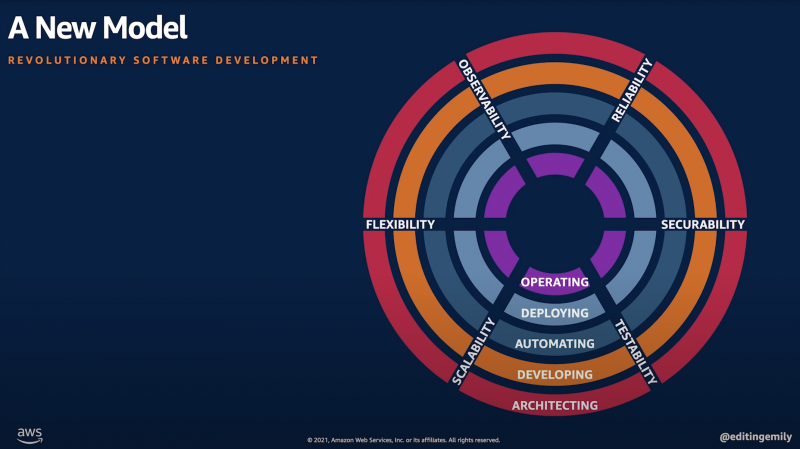 CLOUD
CLOUD
 CLOUD
CLOUD
 CLOUD
CLOUD
With data and analytics morphing into a core business function, and much of it being found in the cloud, cloud native is rapidly breeding innovation. The recent AWS Startup Showcase — “New Breakthroughs in DevOps, Analytics, and Cloud Management Tools” — recently took a look at 14 startups that are innovating, leveraging data and creating unique business propositions.
Here’s a look at five disruptive developments in cloud native that were under discussion during the event. (* Disclosure below.)
If you thought that automation-based DevOps style of software programming management was here to stay, there are those who say it’s just a passing phase. Author Emily Freeman, who is also head of DevOps product marketing at Amazon Web Services Inc., reckons even the latest, continually updating version of DevOps, known as continuous integration and continuous delivery, should be placed out to pasture.
“DevOps is an increasingly outmoded solution to a previous problem,” Freeman said in an interview with theCUBE.
Freeman, who wrote the book “DevOps for Dummies,” thinks most software systems development lifecycles need rethinking. Planning and analysis, followed by programming, then implementation followed by maintenance — as is the fundamental concept behind all systems development — doesn’t work in a rapid-cloud environment.
The order of events should be more along the lines of architecting, followed by development and automation, then deploying and operating — similar to traditional SDLC methods, according to Freeman. In addition, dynamic and continual roles should be observed by all involved and encompass flexibility, observability, reliability, security, testing and scaling. And those add-ons must happen throughout the entire lifecycle.
“It should build on the foundations of agile and DevOps and represent the iterative [and fuzzy] nature of continuous innovation,” she said.

Partly driven by wasted cloud spending, where idle or overprovisioned cloud resources are eating into an organization’s available cash, CloudOps isn’t simply cost management, according to JT Giri, founder and chief executive officer of AWS provider nOps Inc.
“Our focus is more on operationalizing and actually remediating issues,” he said in an interview with theCUBE.
In a nutshell, Giri is talking about inefficiencies. An example could be creating efficient data storage and at the same time analyzing and fixing problems related to how it is acted upon.
Prioritization management is also an element to elevate in the newest forms of CloudOps, such as nOps’s version, Giri reckons. He refers to the dichotomy of when cost objectives don’t match with Service Level Agreements, as an example, noting that adopting CloudOps, as opposed to relying on IT management, will fix that.
As DevOps increasingly looks to automation methods and CloudOps takes over from IT management, we’re also seeing a radical shift taking place around how data is handled when it comes to the cloud. We’re entering the third phase of cloud computing as API-driven data mesh replaces data lakes, say analysts.
The premise behind data mesh is that data lakes and traditional storage is bypassed, and that data is interrogated and analyzed at its source, including the edge. This falls into step with an increasing reliance on the leveraging of data for modernization and digitization thrusts by companies.
Meal-kit vendor HelloFresh is an adopter of data mesh, presenting its use case at the AWS event.
The company delivered 239 million meal kits in 14 countries in a recent quarter. “Data mesh is an architecture of scale,” Christoph Sawade, global senior director of data for HelloFresh, said in an interview with theCUBE. He believes his company’s data quality deteriorated the more the startup scaled. That caused HelloFresh to re-evaluate the structure. An acceptance of decentralized models, rather than forcing the data into a monolithic structure, allowed the company to focus on growth.
“Marketing, supply chain, finance and human resources, analytics teams started to build their own data solutions,” Clemence Chee, global senior director of data at HelloFresh, who joined Sawade, said of the early days. “The data pipelines didn’t reach the engineering standards. The majority of time was spent in meeting rooms to align on data quality.”
A complete data architecture re-think, with an acceptance of data decentralization, allowed the company to build the data products it needed with standards and governance that works.
Google, Amazon Web Services and Microsoft Azure are on the defensive, as a slew of cloud native startups are taking aim to capture part of the public cloud market share, according to one venture capitalist.
“There are 500-plus services between all three cloud vendors, but there are 500-plus startups competing against the cloud vendors,” Jerry Chen, partner at venture capital investor Greylock Partners, said in an interview with theCUBE.
Unicorn startups are poised to “storm the castle,” Chen added, including MongoDB Inc., known for its databases; Snowflake Inc. data cloud; Databricks Inc. architecture; and HashiCorp Inc. workflows on the attacker list.
“Snowflake has created a hole in that castle wall against [Amazon cloud data warehousing offering] Redshift,” Chen said.
Startups must continually push the envelope in terms of providing compelling data-sourced content for consumer users, according to Victor Chang, vice president of ThoughtSpot Everywhere and corporate development at ThoughtSpot, in an interview with theCUBE.
Even though digital offerings are significantly more exciting than offerings from a few years ago, consumers will continue to demand evolving technology, Change added. Thus, apps must get to a space where they are more than simply providing static data dashboards for consumers.
Tapping analytics for the dashboards is the way forward, according to Chang, and his company pulls analytics — not normally found in a consumer-facing app — for the developer to present. It helps the customer engage with the app more, Chang added. An example would be an end-user microcustomizing categories of credit card transactions in a banking app.
“Everyone can access a little bit more of their data and get more value out of it,” Chang said.
(*Disclosure: This event was sponsored by participating companies. Neither AWS nor other sponsors have editorial control over content on theCUBE or SiliconANGLE.)
THANK YOU